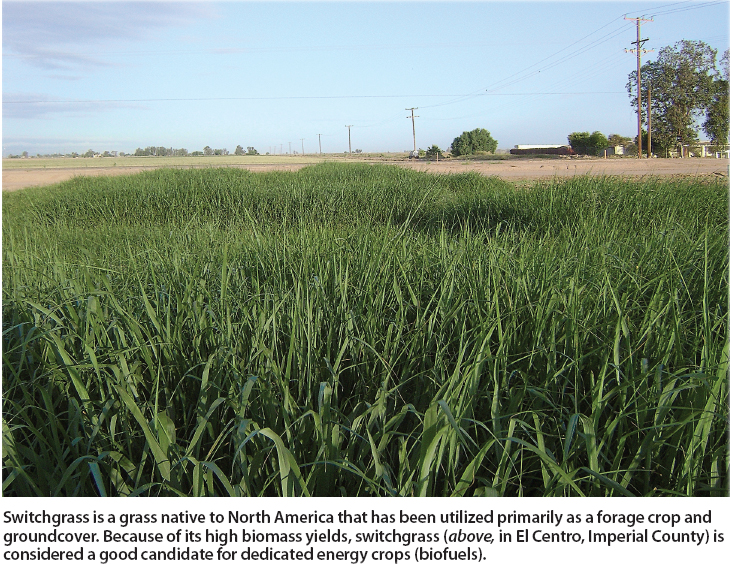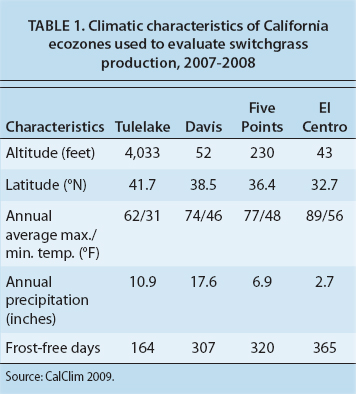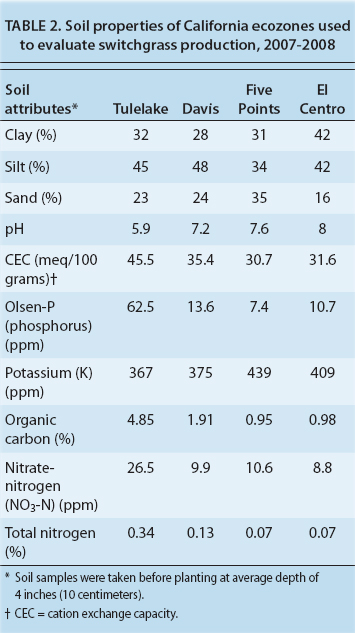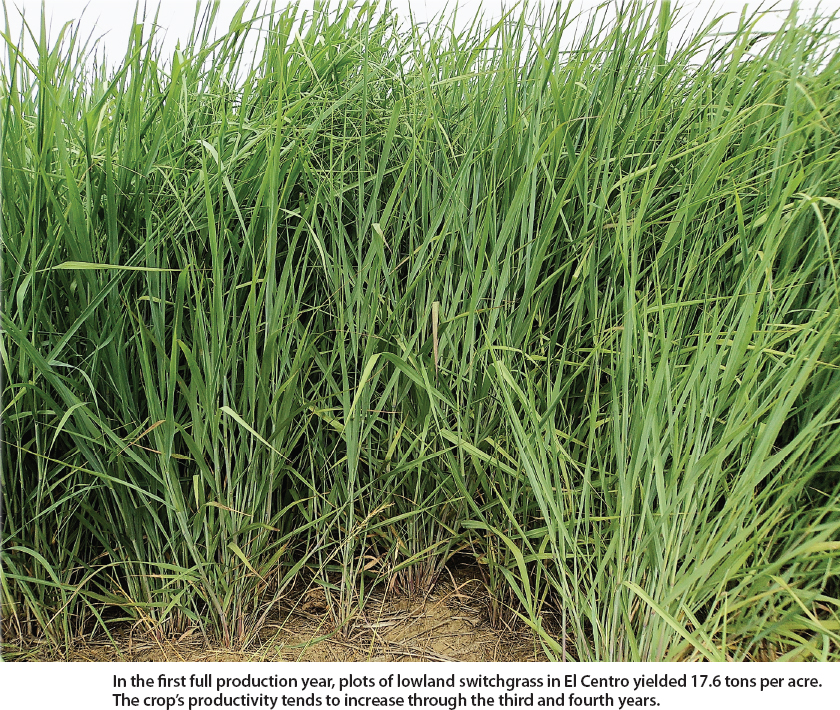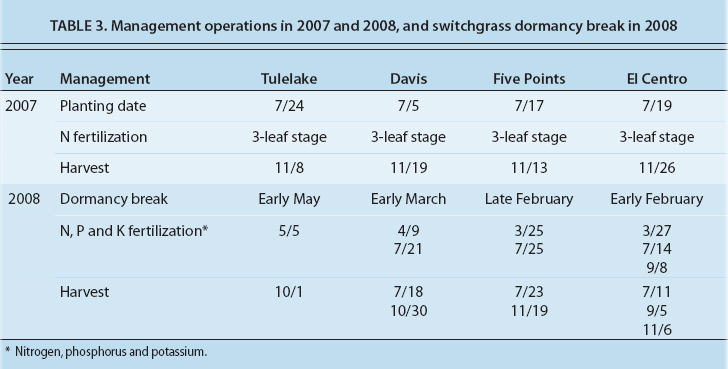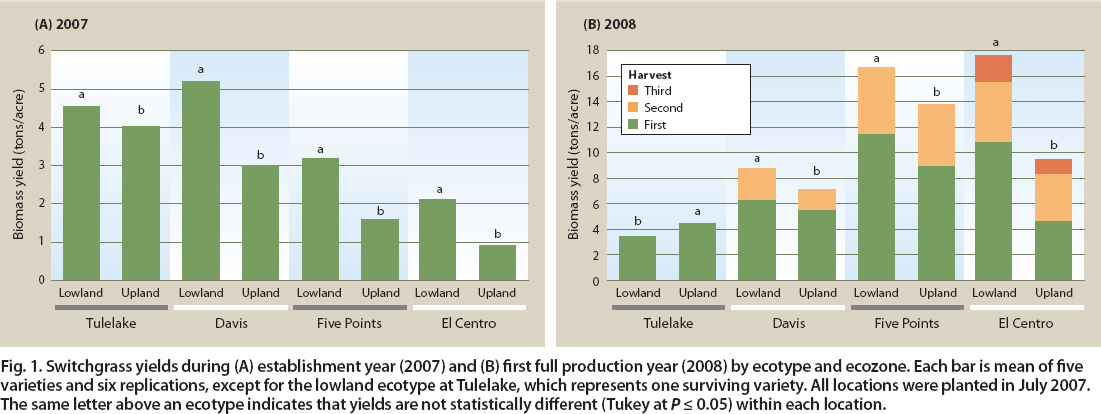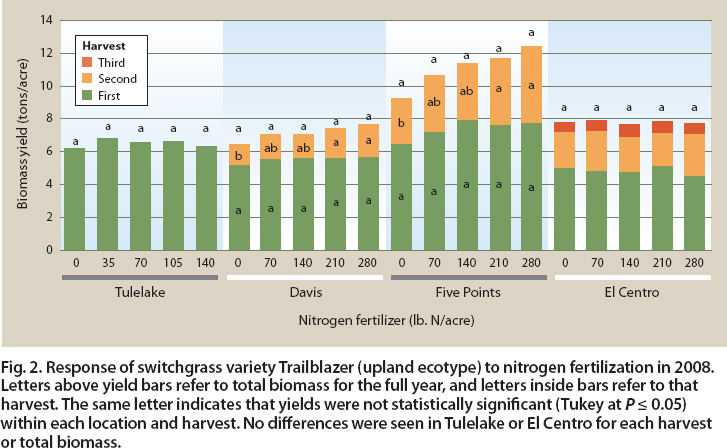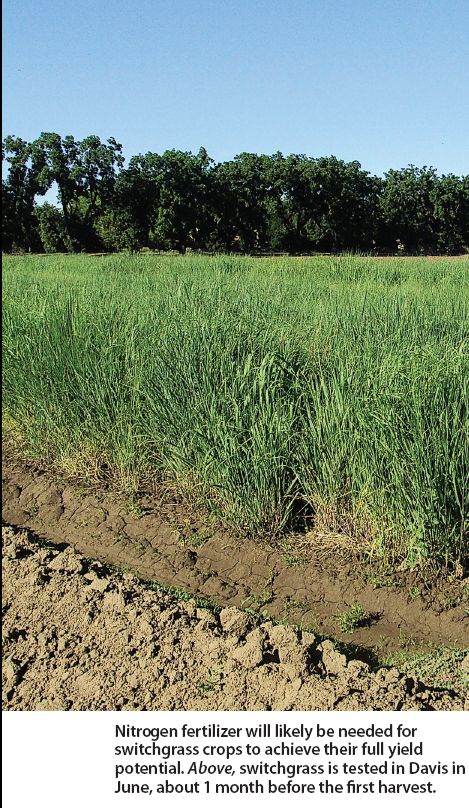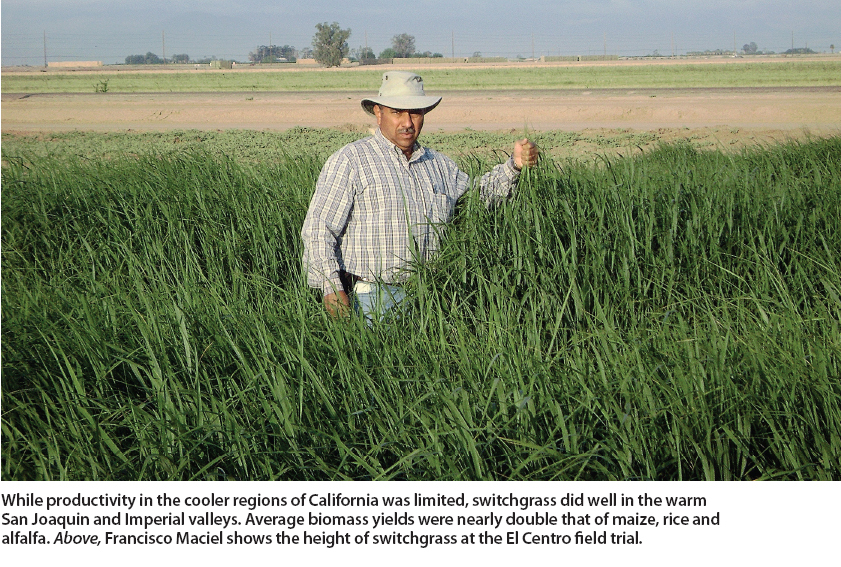All Issues
Switchgrass is a promising, high-yielding crop for California biofuel
Publication Information
California Agriculture 65(3):168-173. https://doi.org/10.3733/ca.E.v065n03p168
Published September 01, 2011
PDF | Citation | Permissions
Abstract
Ethanol use in California is expected to rise to 1.62 billion gallons per year in 2012, more than 90% of which will be trucked or shipped into the state. Switchgrass, a nonnative grass common in other states, has been identified as a possible high-yielding biomass crop for the production of cellulosic ethanol. The productivity of the two main ecotypes of switchgrass, lowland and upland, was evaluated under irrigated conditions across four diverse California ecozones — from Tulelake in the cool north to warm Imperial Valley in the south. In the first full year of production, the lowland varieties yielded up to 17 tons per acre of biomass, roughly double the biomass yields of California rice or maize. The yield response to nitrogen fertilization was statistically insignificant in the first year of production, except for in the Central Valley plots that were harvested twice a year. The biomass yields in our study indicate that switchgrass is a promising biofuel crop for California.
Full text
Switchgrass is a perennial, warm-season (C4) grass native to North America. One of the dominant species of the North American tallgrass prairie, switchgrass (Panicum virgatum) grows naturally in remnant prairies and native grass pastures, and along roadsides throughout the continental United States, except in California and the Pacific Northwest (USDA 2006). Agriculturally, it has been used primarily as forage and for grazing and groundcover. Recently, however, it has emerged as one of the most promising cellulosic biofuel crops for ethanol production.
California consumes more ethanol than any other U.S. state. California gasoline contains about 6% ethanol by volume (since the substitution of MTBE [methyl tert-butyl ether] in 2004), resulting in annual ethanol consumption of nearly 1 billion gallons (3.78 million cubic meters). Of that, about 80% is maize-based ethanol transported by rail from the Midwest; 12% is sugarcane-based ethanol shipped from Brazil; and 8% is ethanol from maize grains produced in-state (CEC 2010). The proportion of ethanol blended in California gasoline is expected to increase to 10% by 2012, resulting in ethanol demand of 1.62 billion gallons (6.12 million cubic meters) per year if no gasoline consumption changes occur (CEC 2007). If in-state production does not increase, California will need to import more than 95% of its ethanol by 2012.
Switchgrass is a grass native to North America that has been utilized primarily as a forage crop and groundcover. Because of its high biomass yields, switchgrass (above, in El Centro, Imperial County) is considered a good candidate for dedicated energy crops (biofuels).
Currently, most of the ethanol used in California is produced by fermenting the sugar in Brazilian sugarcane and the starch in Midwestern grains (Macedo et al. 2008). Technology is being developed to produce ethanol from cellulose, the most abundant structural carbohydrate in plants; the cellulose content of switch-grass, for example, is about 40% (Isci et al. 2008). Cellulose cannot be directly fermented to produce ethanol; it needs to be broken down into more simple sugars. There are different processes of lingo-cellulose conversion into ethanol, such as strong acid hydrolysis followed by fermentation (SHF) and simultaneous saccharification and fermentation (SSF). Significant challenges remain and need to be overcome before the technology can be commercially used (CEC 2010).
Compared to maize grain–based ethanol, which is the only ethanol currently produced in California, cellulosic ethanol has higher productivity and net energy value, and lower net greenhouse-gas emissions (Adler et al. 2007). Cellulosic ethanol can also be produced from nonfood crops, waste and forest products, diminishing the possible inflationary effects on food prices if land used to produce food were diverted to ethanol crops.
Potential of switchgrass
There are many possible crop sources for cellulosic ethanol production in California, including agricultural and urban wastes, rice and wheat straw, wood chips from tree pruning and dedicated energy crops. Crops with high biomass yields, such as switchgrass, elephantgrass (Pennisetum purpureum) and miscanthus (Miscanthus × giganteas) are good candidates for dedicated energy crops. The advantages of switchgrass are its high yield potential, excellent soil conservation attributes and good compatibility with conventional farming practices (McLaughlin et al. 1999). Like most field crops, for example, switchgrass is established from seeds, whereas elephantgrass and miscanthus are established by transplanting billets and rhizomes. Also, switchgrass is no longer on the California Department of Food and Agriculture list of noxious weeds (CDFA 2010).
Under rain-fed conditions of the Midwest and southern United States, switchgrass biomass yields have ranged from 2.5 to 11 tons per acre (5.5 to 25 metric tons per hectare) (Fike et al. 2006; Heaton et al. 2004; McLaughlin et al. 1999; Schmer et al. 2008). The responses of switchgrass crops to nitrogen fertilizer have been variable and conflicting. Some studies report limited or no yield response (Christian et al. 2001; Thomason et al. 2004), while others have found significant yield increases due to nitrogen fertilization (Lemus et al. 2008; Muir et al. 2001; Stroup et al. 2003). Nitrogen response is an important area of study because nitrogen fertilizer is the main energy input and the main source of greenhouse-gas emissions during switchgrass cultivation (Adler et al. 2007; Schmer et al. 2008). Understanding how switchgrass responds to nitrogen will help researchers develop energy-efficient and environmentally benign production systems for biomass energy crops.
Because it can be used both as forage and as a biofuel crop, switchgrass may be well suited to California, a state with a large livestock industry and higher ethanol consumption than any other. However, there is little information about switchgrass production in California, nor in other irrigated regions. Irrigated Western regions are significantly different in climate and cropping patterns than the Midwest or southern United States, where most switchgrass research has been carried out. California's Mediterranean climate suggests greater yield potential but also higher water and nitrogen requirements.
Switchgrass can be separated into two ecotype groups: lowland and upland. Lowland ecotypes are found in floodplains and are taller (around 6 feet), coarser with a more bunch-type growth habit and may be more rapid growing than upland ecotypes. In contrast, upland ecotypes are found in drier upland sites and are finer stemmed, broad based and often semi-decumbent (Porter 1996). Usually, lowland ecotypes flower and mature later than upland ecotypes.
Switchgrass is not native to California, and no information has been available about the adaptability of lowland and upland ecotypes in California. In addition, California has different ecozones — areas defined by distinct climate patterns, landscapes and plant species. Therefore, it is possible that one ecotype is better adapted to one ecozone than another. The objectives of our research were to identify (1) how well the lowland and upland switchgrass ecotypes would adapt to the major ecozones in California, (2) the biomass yield potential for each ecozone and (3) the response of upland switchgrass to various nitrogen fertilizer rates.
Switchgrass ecotype trials
To identify the suitability of lowland and upland switchgrass ecotypes for California, and to test the adaptation of the crop itself, we established trials in July 2007 at four California locations with different climate characteristics and soil attributes (tables 1 and 2). Tulelake (Siskiyou County), the northernmost site on the border with Oregon, is typical of the intermountain regions of California and other parts of the Pacific Northwest. Davis (Yolo County) is situated in the Sacramento Valley, and Five Points (Fresno County) is in the San Joaquin Valley. El Centro (Imperial County) was the southernmost site and represents a low desert agricultural region typical of the Sonoran deserts of California, Mexico and Arizona.
TABLE 1. Climatic characteristics of California ecozones used to evaluate switchgrass production, 2007–2008
In each location, we evaluated five lowland and five upland varieties. However, the lowland varieties slightly varied across sites, so we tested six lowland varieties total, but only five per site. Lowland ecotypes included two released varieties (Alamo and Kanlow) and four experimental varieties. The upland ecotypes included four released varieties (Trailblazer, Cave in Rock, Blackwell and Sunburst) and one experimental variety. The trials were a completely randomized block design with six replications. At all locations, the seedbed was prepared to provide a firm and fine soil surface. Switchgrass was drill seeded in July 2007 at a rate of 5 pounds per acre (5.6 kilograms per hectare) of pure live seeds, at a depth of 0.25 inch (0.6 centimeter) and with 10 inches (25.4 centimeters) between rows. Plot size was 10 by 15 feet (3 by 5 meters). The plots were sprinkler irrigated after seeding to ensure good germination. No fertilizer was applied at planting, but at the three-leaf stage nitrogen (N) was applied in the form of ammonium sulfate at a rate of 50 pounds per acre (56 kilograms per hectare).
In the first full production year, plots of lowland switchgrass in El Centro yielded 17.6 tons per acre. The crop's productivity tends to increase through the third and fourth years.
All fields were harvested in November 2007, after which the crop entered winter dormancy (table 3). The last harvests at Tulelake, Davis and Five Points were driven in part by the onset of the winter rains or snow; later harvests would have been impractical due to wet soils. Winter dormancy was observed at all sites, including El Centro. El Centro was the first site to break dormancy in early February, followed by Five Points in late February, Davis in early March and Tulelake in early May.
In Tulelake, only one lowland ecotype variety, Kanlow, survived the winter. Lowland ecotypes developed in the southern United States where winters are mild, although frost is not uncommon. Tulelake has average minimum temperatures of 22°F (–5.5°C) during winter and receives 21 inches (53.3 centimeters) of snow annually (CalClim 2009). Therefore, lowland ecotype varieties were generally expected to be unsuitable at this location, which was confirmed by the winter mortality of all except one.
In spring 2008, nitrogen, phosphorus (P) and potassium (K) fertilizers were applied. Nitrogen was applied in the form of ammonium sulfate at a rate of 100 pounds per acre (112 kilograms per hectare). Phosphorus (P2O5) and potassium (K2O) were each applied at a rate of 50 pounds per acre (56 kilograms per hectare).
During the 2008 growing season, the number of switchgrass harvests varied among sites due to climatic differences. The plots were harvested once at Tulelake (October), twice at Davis and Five Points (July and October/November) and three times at El Centro (July, September and November). After the first and second harvests, 100 pounds nitrogen per acre (112 kilograms per hectare) was applied in the form of ammonium sulfate.
Flowering differences
In 2007, we recorded flowering differences among ecotypes and locations at harvest, because early flowering has been associated with lower yields (Hopkins et al. 1995). The upland varieties exhibited higher flowering percentages (percentage of flowering tillers) than the lowland varieties at all locations, and flowering percentages were higher in the southern locations due to the longer season and warmer temperatures. In Tulelake, 5% to 10% of tillers on average were flowering in the upland ecotypes across all varieties, and no flowering was observed in the lowland ecotypes. At Davis and Five Points, there was 15% to 25% flowering for upland and 0% to 10% for lowland ecotypes. The highest flowering percentages were found at El Centro, ranging from 50% to 75% for upland and 10% to 40% for lowland ecotypes.
In 2008, the upland ecotypes once again exhibited higher flowering percentages at the first harvest than the lowland ecotypes at all locations: average flowering percentages observed in lowland and upland ecotypes respectively were 2% and 48% at Davis, 4% and 66% at Five Points, and 6% and 70% at El Centro. At Tulelake, the single-harvest location, the only surviving lowland variety exhibited 30% flowering, while all the upland ecotypes showed 100% flowering. Only small differences in flowering among ecotypes were seen at the second harvest. Davis showed 47% and 35% flowering, Five Points 77% and 71%, and El Centro 29% and 8% for lowland and upland ecotypes, respectively. In our trials, early flowering was also correlated with lower yields, in accordance with other studies (Hopkins et al. 1995).
Biomass yields
In the 2007 establishment year, the lowland ecotypes yielded significantly more biomass than upland ecotypes at all locations, but these differences were less evident at Tulelake (fig. 1A). The highest biomass production was achieved by lowland ecotypes in Davis at 5.2 tons per acre (11.6 metric tons per hectare). El Centro had the lowest yield, with upland ecotypes producing only 0.8 ton per acre (1.7 metric tons per hectare). Biomass yields of switchgrass in the establishment year are expected to be lower than in subsequent years. Our establishment yields were similar to those reported in other U.S. studies (Muir et al. 2001) and in Mediterranean climates of Europe (Alexopoulou et al. 2008). We planted the switchgrass in July, and it is likely that an earlier planting date would have resulted in higher yields. Vassey et al. (1985) compared early, mid-and late-spring planting dates and found that the highest yields were achieved with the earliest planting dates.
Fig. 1. Switchgrass yields during (A) establishment year (2007) and (B) first full production year (2008) by ecotype and ecozone. Each bar is mean of five varieties and six replications, except for the lowland ecotype at Tulelake, which represents one surviving variety. All locations were planted in July 2007. The same letter above an ecotype indicates that yields are not statistically different (Tukey at P< 0.05) within each location.
In 2008, the first full production year, yields were generally higher than in 2007 (fig. 1B). The lowland ecotype yields were higher than upland ecotypes at all locations except for Tulelake, where only one lowland ecotype survived the first winter. Yields of lowland ecotypes averaged 8.7, 16.7 and 17.6 tons per acre (19.4, 37.4 and 39.4 metric tons per hectare) in Davis, Five Points and El Centro, respectively. The upland varieties were not well suited to the warmer locations, but in Tulelake all the upland varieties produced similar yields, which were higher than yields of the single surviving lowland variety.
At locations with multiple harvests, the first harvest produced significantly more biomass than subsequent harvests for all varieties. Of the total biomass, 73%, 67% and 57% was obtained in the first harvest at Davis, Five Points and El Centro, respectively (fig. 1B). At El Centro, the third harvest produced only 12% of the total annual biomass yield.
The 2008 yields achieved in our trials were substantially higher than those reported by Heaton et al. (2004) from 21 studies of mature switchgrass stands around the United States (3 years or older). In their studies, yields averaged 4.6 tons per acre (10.3 metric tons per hectare) and ranged from approximately 0.5 to 9.8 tons per acre (1.1 to 22 metric tons per hectare). Furthermore, we expect yields in our California plantings to increase in the following 1 to 2 years. Productivity tends to increase until the switchgrass stand reaches maturity and full yield potential at 3 or 4 years old (Sharma et al. 2003).
Nitrogen trials
Trials were conducted in the same four locations in 2008 to evaluate the yield response of the upland ecotype variety Trailblazer to different levels of nitrogen fertilizer. Nitrogen fertilizer was applied at each location at annual rates of 0, 70, 140, 210 and 280 pounds per acre (0, 75, 150, 225 and 300 kilograms per hectare) in Davis, Five Points and El Centro In Tulelake, the nitrogen rates were half that of the other locations (0, 35, 70, 105 and 140 pounds per acre), due to the single harvest and shorter growing season. Five Points and El Centro received all nitrogen fertilizer in March and April, in two applications spaced 4 weeks apart. In Davis, the first nitrogen fertilizer application was in April and the second in July, after the first harvest. Tulelake received nitrogen fertilizer in one single application in May. The plots were adjacent to plots of the ecotype trials and were established at the same time in 2007 and harvested at the same time.
Overall yields were lowest at Tulelake and El Centro, averaging only 6.5 and 7 tons per acre (14.5 and 15.6 metric tons per hectare), respectively (fig. 2, page 172). Trailblazer is an upland variety, and in the ecotype variety trials it usually had lower yields than the lowland varieties (fig. 1B). Total annual biomass yields showed no response to nitrogen treatment at any location. This may be due to switchgrass's deep root system, reportedly up to 10 feet (3 meters), which is able to explore large amounts of soil for nitrogen (Parrish and Fike 2005).
Fig. 2. Response of switchgrass variety Trailblazer (upland ecotype) to nitrogen fertilization in 2008. Letters above yield bars refer to total biomass for the full year, and letters inside bars refer to that harvest. The same letter indicates that yields were not statistically significant (Tukey at P ≤ 0.05) within each location and harvest. No differences were seen in Tulelake or El Centro for each harvest or total biomass.
While there was no response to nitrogen fertilizer in the first harvest yields at any location, the second harvest at both Davis and Five Points showed a significant yield response when the two highest nitrogen treatments were compared to the plots that received no nitrogen. This suggests that over time switchgrass depleted the native soil's nitrogen reserves and required fertilizer nitrogen to achieve its yield potential. Muir et al. (2001) reported just such a situation: switchgrass depleted native soil nitrogen reserves when receiving no nitrogen fertilizer, and over time yield differences between unfertilized and nitrogen-fertilized switchgrass increased. Christian et al. (2001) found no yield response to nitrogen fertilizer during a 5-year study, but that was mainly because soil supply and deposition were adequate to support the low average yields of 4 tons per acre (8.9 metric tons per hectare), and the researchers affirmed that long-term management strategies would be necessary to avoid deficits in soil nitrogen. With the high yield potential of switchgrass in California and consequent high nitrogen removal, California growers would most likely need to apply nitrogen fertilizer (and other nutrients) to sustain yields.
Nitrogen fertilizer will likely be needed for switchgrass crops to achieve their full yield potential. Above, switchgrass is tested in Davis in June, about 1 month before the first harvest.
Further research is still needed to improve nitrogen management, but it is likely that a switchgrass variety with higher yielding potential than Trailblazer would show a greater response to nitrogen fertilizer. We found that the plants were green at the first harvest, with high nitrogen content, resulting in high rates of nitrogen (and possibly other nutrients) removal from the soil, which in production fields would need to be replenished. Likewise, multiple-harvest systems are likely to require more fertilizers than single-harvest systems. In multiple-harvest situations, the crop's nutrient content is high at the first harvest, generally in midsummer. The last harvest (or the one harvest of single-harvest systems) takes place in the fall after the plants have senesced. During senescence, most nutrients, including nitrogen, likely retranslocate to the roots, becoming available for next year's growth. Retranslocation to the roots can increase nitrogen conservation within the plant-soil system and may reduce nitrogen fertilizer requirements in subsequent years. Further research is necessary to quantify nitrogen removal and develop nitrogen management strategies for single- and multiple-harvest crops.
Promising biofuel crop
Our results suggest that switchgrass has high yield potential in California. Although its productivity in the state's cooler mountain regions is limited, productivity is considered good in the San Joaquin and Imperial valleys. Switchgrass had moderate yields in the establishment year and up to 17 tons per acre (38 metric tons per hectare) in the second year. By comparison, California maize and rice produce approximately 9 tons per acre (20.1 metric tons per hectare) of total biomass (grain plus stover), and alfalfa produces 7 to 8 tons per acre (15.6 to 18 metric tons per hectare). Therefore, the switchgrass yields reported here are promising both for forage and use as a biofuel crop.
Our results show that switchgrass requires little or no nitrogen in the establishment year, suggesting that it can efficiently use the native soil nitrogen pool; but switchgrass may require nitrogen fertilizers in multiple-harvest systems in the second and subsequent years in order to sustain high yields. In addition to the effect of multiple harvests on nitrogen removal, the harvesting and transportation costs (machinery, fuel and labor) of multiple harvests should be considered when evaluating the production and economic feasibility of switchgrass as a biofuel crop. Water use also elicits concern in California. Switchgrass is a C4 plant, and it is expected to show high rates of transpiration efficiency due to its more efficient photosynthesis pathway. Although not determined in these trials, we are currently researching water use in switch-grass production.
Productivity is dependent on ecotype varietal selection and proper fertility management. Upland varieties were best suited for Tulelake and the cooler mountain regions; most lowland varieties did not survive the first winter. For all other locations, where winter survival was not a concern, the lowland varieties were better adapted and achieved higher yields than the upland varieties.



